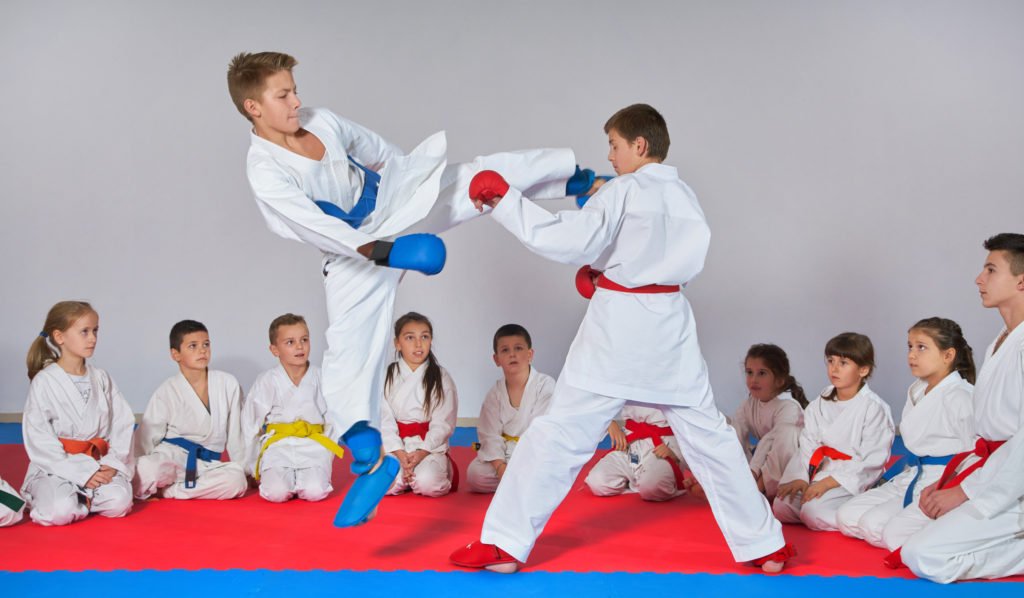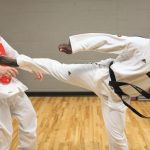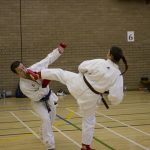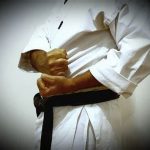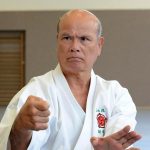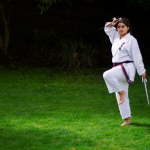Karate sparring is an important part of the martial art and has been practiced for centuries.
It allows practitioners to hone their skills, test their reflexes, and learn how to defend themselves in a controlled environment. Sparring is also a great way to stay in shape, build confidence, and develop discipline.
It is also a great way to make friends and have fun. In addition to these benefits, karate sparring helps practitioners understand martial arts better by teaching them how to apply techniques in real-world situations.
Sparring provides an opportunity for practitioners to learn how to control their emotions and reactions in stressful situations. It also teaches them how to think on their feet and react quickly to gain the upper hand in a fight.
Finally, karate sparring helps practitioners develop a sense of respect for their opponents, which is essential for any martial artist.
All of these reasons make karate sparring an important part of martial arts and a great way for practitioners to improve their skills and become better martial artists.
What is Sparring?
Sparring is an essential part of karate training.
It is a form of practice in which two people engage in simulated combat using the techniques and principles of karate. The main purpose of sparring is to give the practitioner a chance to practice their techniques and strategies against a live opponent.
This helps to develop their speed, agility, power, and accuracy. It also gives them a chance to test their physical and mental capabilities in a safe environment.
Sparring also allows practitioners to become more comfortable with the techniques they have learned and to gain confidence in their abilities.
Benefits of Karate Sparring
Sparring has many benefits for karate practitioners.
It helps them develop their physical skills, such as speed, agility, power, and accuracy. It also helps them to become more comfortable with the techniques they have learned and to gain confidence in their abilities.
Sparring provides a safe environment for practitioners to test their physical and mental capabilities against an opponent. Furthermore, it can be used as a form of competition between students or even between different dojos or clubs.
Finally, sparring can help practitioners learn how to control their emotions during combat situations and how to remain calm under pressure.
Types of Sparring
Several different types of sparring are used in karate training.
Light-contact sparring involves minimal contact between opponents, while full-contact sparring involves full-force strikes and kicks between opponents. Both forms of sparring can be used for both recreational and competitive purposes.
Other forms of sparring include point sparring, which involves scoring points based on successful strikes or blocks; free-style sparring, which allows for more creative combinations; and grappling-style sparring, which focuses on ground fighting techniques such as throws and joint locks.
Safety Considerations
Safety is always an important consideration when engaging in any type of physical activity, including karate sparring.
Protective gear such as gloves, shin guards, headgear, mouthguards, and groin protectors should always be worn during sparring sessions.
In addition, all participants need to follow the rules set forth by the instructor or dojo master to ensure everyone’s safety during the session.
Techniques Used During Sparring
Karate practitioners use several different techniques during sparring sessions, including strikes, blocks, counters, throws, joint locks, chokes, and sweeps.
All these techniques must be practiced with care to ensure safety during practice sessions as well as competitive bouts.
Mental Preparation for Sparring
Mental preparation is just as important as physical preparation when it comes to karate sparring.
Practitioners should focus on developing a positive attitude toward the practice session before engaging in any type of physical activity, such as sparring or competition bouts.
They should also strive to remain calm under pressure and maintain focus on their technique rather than worrying about winning or losing the match.
Additionally, they should strive to remain humble even after successful bouts so that they can continue learning from each experience rather than becoming overconfident in their abilities.
Strategies Used During Sparring
Karate practitioners must develop effective strategies when engaging in sparring matches or competitive bouts to maximize their chances of success.
These strategies include developing effective offensive and defensive tactics such as feints, counter-attacks, baiting, footwork and timing.
Additionally, practitioners need to stay aware of their surroundings so that they can react quickly if needed during a match or bout.
Learning From Mistakes During Sparring
Making mistakes during karate sparring is inevitable, but practitioners need to learn from these mistakes so that they can improve upon them in future matches or bouts.
Practitioners should strive to analyze each mistake carefully so that they can identify what went wrong and how they can avoid making similar mistakes again in the future.
Additionally, it is important for practitioners not to become discouraged if they make mistakes but rather use these experiences as learning opportunities so that they can become better martial artists overall.
The Role Of A Sensei In Karate Sparring
The sensei plays an important role when it comes to karate sparring sessions or competitive bouts since he/she is responsible for overseeing all activities taking place within the dojo or club setting where these activities occur.
The sensei is responsible for ensuring that the techniques are practiced properly to ensure the safety of all practitioners involved as well as making sure that everyone follows the rules and guidelines set forth by the instructor or dojo master.
The sensei is also responsible for helping instructors or dojo masters develop effective strategies that can help ensure success during sparring sessions or competitive bouts.
In addition, the sensei is responsible for ensuring that the participants remain focused on learning and improving their skills rather than worrying about winning or losing a match or bout.
Conclusion
Karate sparring is an important part of martial arts and a great way to improve one’s skills as a martial artist.
It helps practitioners develop speed, agility, power, accuracy, and mental focus, as well as gives them a chance to test their physical and mental capabilities in a safe environment.
Furthermore, it can help practitioners learn how to control their emotions during combat situations and how to remain calm under pressure.
Sparring can also help practitioners learn how to develop effective defensive and offensive tactics to help improve their overall skills as martial artists.
Finally, karate practitioners need to develop effective mental strategies before engaging in sparring sessions or competitive bouts so that they can maximize their chances of success.

